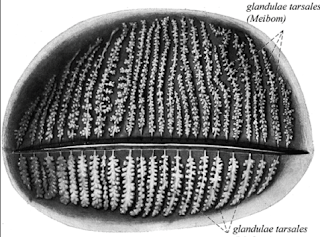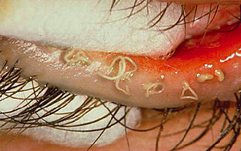How to Get Rid of a Stye Fast and Forever?
How to NEVER have a Stye Again?
Here is the secret to never have an stye or chalazion again, ever!
1. Wash your face with warm/hot water daily (without burning your skin).
If you have a stye, you have to start right away putting a hot towel or hot compress or hot tea bag on the bump/painful area/red area ASAP! Every hour you wait to apply frequent warm/hot compresses will allows that clogged Meibomian Gland to scar–permanently. Once scar sets in, it is very difficult to remove even with surgical excision.
If you have a stye, apply warm hot compresses 100-1000x per day pushing on area to express the gland. When towel or hot compress/tea bag gets cold, dip it back into a pot of hot water or put in microwave again. You can buy gel packs on Amazon/CVS but clean towel works well.
The best way is to get a pot of hot boiling water, dip a tip of a clean towel, check to be sure will not burn your think eyelid skin & then apply with intermittent pressure over sensitive area. It is like popping a zit with warm hot water, but different. The glands are vertical and excrete at the base of the eyelash so applying a vertical pressure up (for the lower eyelids) and down (for upper eyelids) will help milk out the oil that is clogged.
Here is an example of glands that are becoming clogged. If this patient does not clean lids properly with warm/hot compresses & massaging they can each turn into a stye.
Below are the toothpaste like secretions that come out when the Meibomian Gland is not working properly. The oil should come out like olive oil, not like toothpaste. This patient needs to increase his or her Omega 3 intake to 2000-4000mg/day (in the forms of foods, wild salmon, pills), apply more frequent warm/hot compresses with massaging and blinking exercises to help the oil’ composition be more like that of good flowing oil.
2. See the diluted Tea Tree oil routine below: use daily or 2-3x per week to avoid this every happening again.
3. Increase Omega 3 intake 2000-4000mg. For kids, even increasing the amount of Walnuts (if no allergy), wild salmon, chia seeds, flax seeds, herring (we buy on Amazon in tomato sauce and eat 1 can a week usually), will help increase their Omega 3 intake which helps prevent styes.
4. Doxycycline 20mg per day to prevent this forever. Tetracyclines historically have not been used for kids as it can make their teeth turn brown permanently. A recent study below with Doxycycline showed Doxy did not stain kids teeth in kids younger than 8 years old who used short term Doxycycline for Rocky Mountain Spotted Fever.
Hopefully, though, the diluted tea tree oil will prevent your child from ever needing Doxy.
More Information:
Eye pain, chronic tearing, eye redness, itchiness, and acute & chronic dry eye can sometimes be due to a very common malady: clogged meibomian glands. These glands are located at the base of each eyelash. There are approximately 50 glands on the upper eyelids and 25 glands on the lower eyelids. The oily substance produced in these little microscopic glands are crucial to the health of the eye. The meibomian oil is essential to the stability of the tear film by preventing evaporation which can lead to rebound tearing; it functions to properly wash away allergens (thus helps prevent itchiness and redness). If they get clogged or scared, it can lead to significant pain, redness, chronic dry eye, and even to styes, chalazia, preseptal cellulitis, and orbital cellulitis.
Remember that each tear has 3 crucial components:
1. Lipid: comes from the Meibomian glands as described above.
2. Aqueous: comes from the Lacrimal Gland located under lateral lid and orbit near temple area. This is decreased in Sjogrens Syndrome patients especially (if you have dry mouth and arthritis, tell your eyeMD).
2. Mucin: comes from the Goblet Cells located throughout the conjunctiva (the saran wrap like covering over the white part of the eye (the sclera).
Here is a description of the best way to keep these critical glands working as they should.
Keep in mind that some people have more sensitive skin than others. If you have sensitive skin, try a test area of the eye/face prior to the full treatment. Try a different cleaner you have a negative reaction to the first one, but do not stop cleaning your face/eyelids as this leads to a build-up of bacteria and even mites into the base of the eyelash follicle which can lead to long term meibomian gland scarring.
Steps for Best Way to Clean and Wash Your EyeLids: Lid Hygiene
Do this daily: a must in order to improve and prevent symptoms from returning:
(1)Wash face with hot/warm water (as hot as eyes can stand it without burning skin); This heat opens all the pores of your face and especially your eyelids. If your face or eyelids gets uncomfortably flush, decreased the temperature.
(2)Apply a Warm Compress for 3-5min 2x/d; And Massage base of eyelashes without pushing on eyeball to help oil come out. This can be a hot towel that is changed when it gets cold; it can be hot tea bags; hot gel pack; rice in a sock (tied) & placed in the microwave: something that keeps the heat is best. If you are developing a stye or a new chalazion, apply direct heat over the bump, inflamed gland, or painful area of lid as often as you can (a hot/warm cuetip [or even a finger tip in hot water that gently pushes on the gland to express the oil after some heat opens the mouth of the gland works great], as hot as you can stand it without burning the skin 50-100x per day (the more the better early on) may prevent the gland from scarring and needing a surgical excision which is never fun.
(3) Use diluted (50%) baby shampoo or Ocusoft Foam:1x/day; This is the most natural way to get rid of the normal bacteria and in many of us other things like skin mites or demodex that cover our body (hair, teeth, skin). You can do this part in the shower when you wash your hair, for instance. If you are allergic to even diluted baby shampoo, find something that is milder but will still clean off dead skin cells and remove the normal bacteria AWAY from the base of the eyelashes.
(4) If the above does not help or you or your eyeMD see you need something stronger but still want to go the natural route: USE: Tea Tree Oil or Cliradex daily: (Dilution instructions: Dilute Tea Tree Oil 50% to start, more if too strong; you can also use Tea Tree Oil TTO shampoo (TTO shampoo in warm water: 1 part in 50) 1x/wk): For the Cliradex, you can cut the towelette into multiple pieces and store in a ziplock bag to prevent it from drying out. Some patients need diluted Tea Tree Oil 2x/day to find relieve, some need it 1x/wk or 1x/month. You will learn when your eyes need them: if you wake up with stuck together eyelids or discharge or foreign body sensation or have redness, increase the warm compress routine and cleaning with TTO.
How to Use Tea Tree Oil: Close eyes & wipe base of eyelashes; allow to air dry 1 minute if you can tolerate; if burning is severe, wash off with warm water prior to opening eyes. You can also dilute the TTO or Cliradex in a bit of water before hand; The goal here is to use as much of the pure stuff as you can at the base of the eyelashes without incurring an allergic reaction. Burning, itching, redness with TTO can last few days: can be allergy or death of demodex mite; decrease or stop if any of above sx intolerable & let us know.
(5) If there is no improvement or if you need immediate improvement or if your eyeMD sees enough bacteria under the microscope, the eyeMD will likely prescribe a medicated ointment that needs to be obtained with a Rx at the pharmacy:
Instruction for all eyelid ointment:
1) Apply 1/4 inch to eyelid base (trying to get at the base of the eyelash follicle) before bed after lid hygiene above.
2) All ointments blur vision so be careful if you get up at night so as not to fall. You can also apply the ointment in one eye one night and the other eye another night if you are at risk for a fall if you wake up at night and cannot see as you need to.
3) You can sleep on a towel to avoid the ointment from getting on the pillow.
4) Wash it off with warm water in the morning as described above.
Types:
a. Erythromycin:
b. Bacitracin:
If more significant bacteria is noted or scarring is noted in the glands, a stronger ointment is given:
c. Tobradex
d. Maxitrol ointment
e. AzaSite 2x/d works very well, but is considered a 2nd line antibiotic as it is super strong (think: bazooka for a unarmed paddle boat), is very expensive, and we like to reserve this for serious bacterial infections to prevent you from becoming resistant to it when you really need it.
If you develop worsening redness, swelling, itching with any of the above treatments, it can be an allergy (Tea Tree Oil can cause redness due to the death of the demodex mite, which is a good thing; dilute the TTO and see if symptoms persist, if they do, it could be an allergy; as of Feb 2014, I have not seen anyone have a true allergy to Cliradex since I started prescribing it in June 2013).
If you develop an allergy, stop the offending agent, and place cold ice pack over the affected area. Let your MD know if you need another option.
References:





